Alexandre Hogue and other artists depicted America’s oilfields during the Great Depression.
“Oil Fields of Graham,” a 1939 mural by Alexandre Hogue, can be found in its original Texas community’s U.S. Postal Service building, a Graham museum preserving the work of oil art.
During the Great Depression, when President Franklin Roosevelt created public projects like the New Deal Federal Arts Program, Alexandre Hogue and other artists received commissions to illustrate scenes of America and its history on the walls of public buildings.
Among his paintings, the artist’s petroleum-related work include “Oil Fields of Graham” (1939), a 12-foot mural now on exhibit in the city’s historic U.S. Post Office building.

Alexandre Hogue’s 1939 “Oil Fields of Graham,” 12 feet wide and 7 feet high, is preserved in the Old Post Office Museum & Art Center in Graham, Texas.
Born in Memphis, Missouri, on February 22, 1898, Hogue — a future professor emeritus of art at the University of Tulsa — grew up in Denton, Texas. His paining skills made him known for stark depictions of southwestern scenes, including murals of the 1930s petroleum industry.
After graduating from Bryan Street High School in Dallas in 1918, Hogue moved to Minneapolis, where he attended the Minneapolis College of Art and Design. He returned to Texas and worked as an illustrator for the Dallas Morning News before traveling to New York, where he worked in advertising — similar to another young artist, Theodor Geisel (see Seuss I am, an Oilman).
While in New York, Hogue continue to refine his painting skills, making frequent visits to museums and galleries. Thanks to Roosevelt’s Federal Arts Program, he returned to Texas to produced artwork to be displayed in Dallas, Houston, and at the small U.S. post office in Graham.
In 1937, Alexandre Hogue was commissioned to paint oil and natural gas activities in West Texas, including Pecos County, home of Permian Basin oilfield. He explored communities and the land owned by ranchers Ira and Ann Yates (see Alley Oop’s Oil Roots).
For the next seven years, Hogue created dramatic scenes of a land ravaged by the Dust Bowl. His West Texas landscapes often included images of oil and natural gas exploration and production.
“Pecos Escarpment”
Among Hogue’s paintings, murals, and lithographs of the petroleum industry at work, in 1939 Hogue painted Pecos Escarpment, created by commission for a Fortune magazine article about Gulf Oil Company. The work in a Permian Basin oilfield features three oil tanks in front of an escarpment with rigs and wells in the distance.
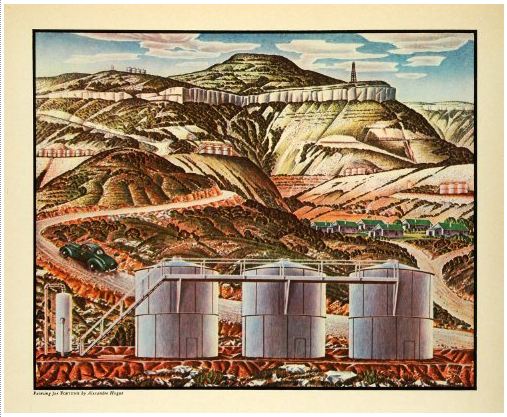
In his 1937 painting “Pecos Escarpment,” Alexandre Hogue depicts an oilfield at Pecos, Texas, with rows of oil storage tanks, a drilling rig, and the green-roofed quarters of oilfield workers.
“Hogue’s works aren’t mere replicas of terrain. Rather, they reveal the mysterious delight that limns the interstices of hills, canyons, and rural structures,” proclaimed a 2011 National Endowment for the Arts article in Humanities. “Fire on the Walls: Texas looks at the land through the eyes of artist Alexandre Hogue,” noted magazine.
Hogue described his painting to the Dallas Morning News: “Oil here complements nature…The shiny tanks, often repeating cylindrical formations in the limestone cliffs, reflect the light very subtly, and the whole effect is one of extraordinary beauty.”
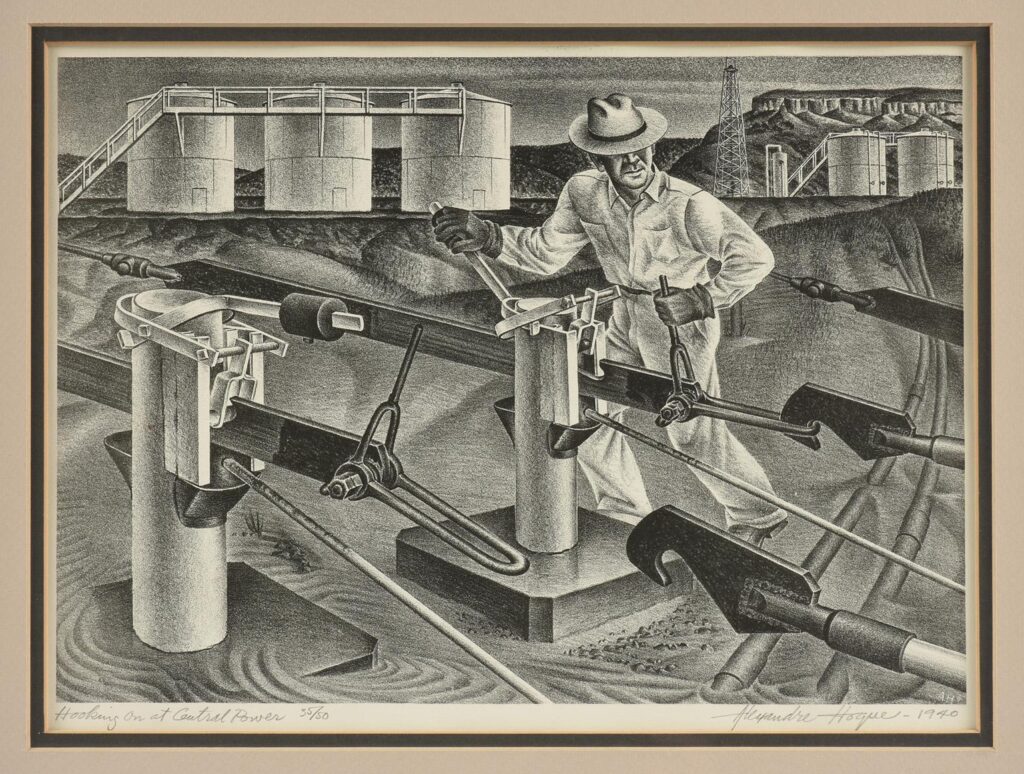
“Hooking on at Central Power,” a 1940 Alexandre Hogue lithograph, 10 x 14 inches, was added to the collection of the Philadelphia Museum of Art in 1981.
The Philadelphia Museum of Art includes six Hogue lithographs in its collection, including two from West Texas oilfields, “Hooking on at Central Power” from 1940, and “Oil Man’s Christmas Tree,” 1941.
The Dallas Nine
Most of Hogue’s art featured landscape paintings, but he also explored abstract styles later in his career, according to the Texas State Historical Association (TSHA). He gathered with other Dallas-area artists — Jerry Bywaters, Otis Dozier, Everett Spruce and others who became known as the Dallas Nine.

“Dust Bowl,” 1933, oil on canvas, by Alexandre Hogue (1898-1994), in the collection of the Smithsonian American Art Museum, Washington, DC.
Hogue’s “Dust Bowl” collection, featured in Life magazine in 1937, included his Erosion Series. His Drouth Stricken Area (1934) depicted the era’s devastation and became his most well-known group of paintings. Its view of a house among sand dunes, an emaciated cow, dilapidated windmill, and perched vulture led to a rise in Hogue’s popularity as a Great Depression artist.
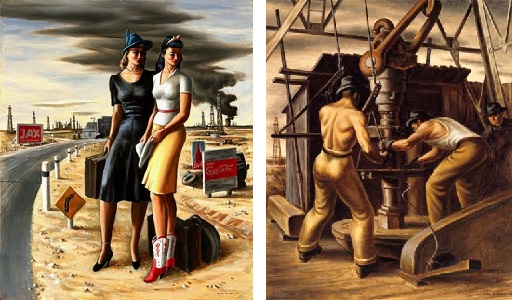
Dallas Nine member Jerry Bywaters (1906-1989) exhibited his paintings “Oil Field Girls” and the “Oil Rig Workers” in 1940.
“Although the Dallas Nine ceased to operate as a group after its members scattered to pursue careers throughout the state and beyond, artists from that circle continued to do meaningful work and exerted a powerful influence over a new generation of artists,” noted TSHA.

Alexandre Hogue’s 1944 “Oil in the Sandhills,” oil on canvas, the Musee National D’Art Moderne, Pompidou Centre, Paris.
In June 1940, Dallas Nine artist Jerry Bywaters of Paris, Texas, exhibited his “Oil Field Girls” at the San Francisco Golden Gate International Exposition. The painting of two young women in a West Texas oilfield and its companion piece, “Oil Rig Workers (Roughnecks)” is among his best-known works.
Bywaters, Hogue and other members of the Dallas Nine “helped establish a regional artistic identity for Texas art,” according to the Blanton Museum of Art at the University of Texas, which acquired “Oil Field Girls.” describing Bywaters’ painting as “a work of incredible moral complexity” in 1984.
Graham Post Office
The federal Works Progress Administration (WPA) initiative during the Great Depression, included post office murals executed by artists working for a 1934 special program of the Treasury Department to improve public buildings.
The federal program would bring Alexandre Hogue to Graham, a small town that began as Fort Belknap on the Texas frontier in 1851.
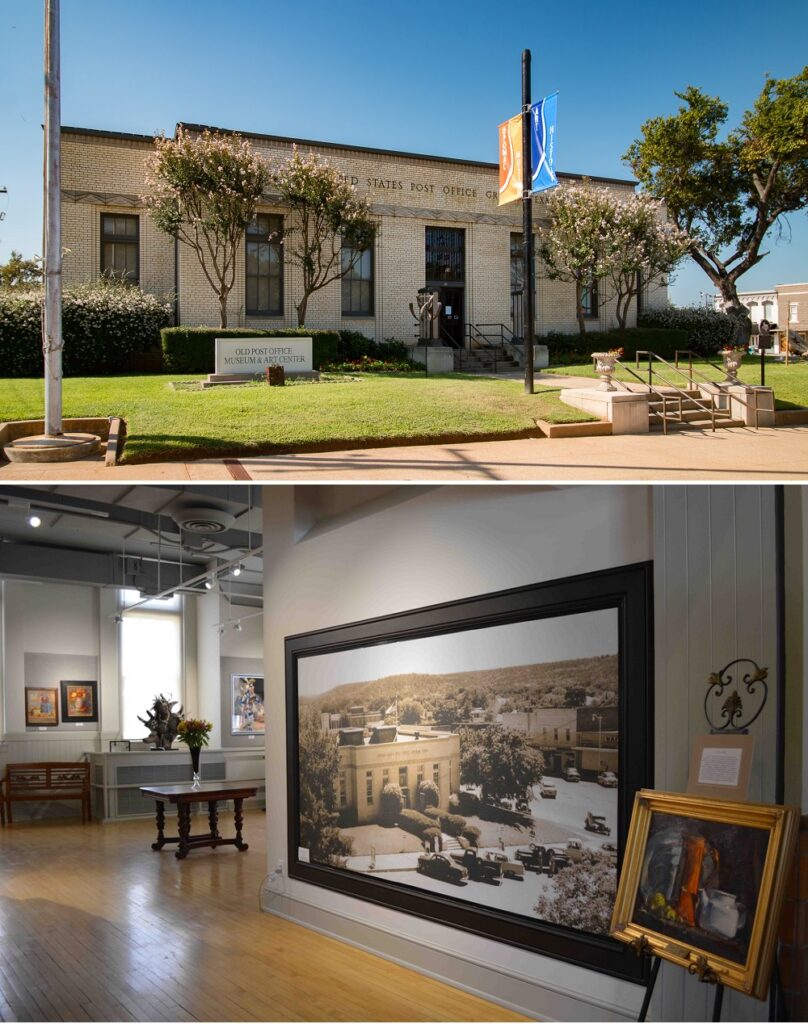
Completed in 1936, the Graham Post Office features Art Deco aluminum grill work and sculptural metal lights. When postal operations relocated in 1992, the city helped turn the historic building into a museum and center for the arts. Photos courtesy Old Post Office Museum & Art Center.
Following the Civil War, two brothers from Kentucky purchased the fort’s local salt plant. Col. Edwin Graham and Gustavous Graham in 1871 drilled among the earliest Texas natural gas wells while searching for additional sources of brine. The town was named for them one year later.
In 1917, an oilfield discovery brought exploration and production companies to Graham, 60 miles north of another discovery the same year — “Roaring Ranger” — and another oilfield found to the south at Burkburnett in 1918.
By the 1920s, Graham was crowded with petroleum-related businesses, including oilfield service companies. The influx of workers quickly overloaded the local post office.
“Young County became the third-richest producing oil reserve in the state of Texas, with Graham in the center of the exploration,” explained Texas historian Nancy Lorance in 2006.
By 1936, a permanent U.S. Postal Service building was completed in the Graham town square. Designed by U.S. Treasury architect Louis Simon, the edifice includes decorative aluminum grill work, sculptural metal lights and “zig-zag art moderne” stone friezes.
Hogue’s “Oil Fields of Graham,” originally adorned the post office lobby’s east wall. The painting depicts Colonel Edwin S. Graham on the left, standing in front of Standpipe Mountain, two laborers working on a pipe line, and two men in street clothes examining blueprints.
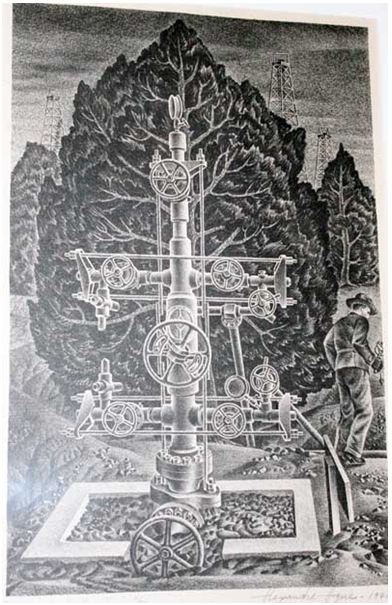
A local oil producer helped Alexandre Hogue with technical details for “Oilman’s Christmas Tree,” and the artist gave him the original “Oil Man’s Christmas Tree,” a 1941 lithograph.
“Also in the picture are a large piece of machinery, some oilfield boilers, and a truck,” Lorance posted on New Deal/WPA Art in Texas.
However, the petroleum boom faded, bringing a sharp population decline, and Hogue’s mural suffered from neglect. “This meaningful picture of Graham deteriorated as the years passed and when the post office was repainted the mural was covered,” Lorance explained.
When Graham’s postal service offices relocated in 1993, the city purchased the original downtown square building. A new Young County museum soon educated the public — and preserved the restored Hogue mural, (which remains on loan from the U.S. Postal Service).
On June 25, 1999, the historic Art Deco building was added to the National Register of Historic Places. Hogue’s mural was restored in 2002 as an exhibit in the newly opened Old Post Office Museum & Art Center in conjunction with the Texas Cattle Raisers Association’s 125th anniversary.
Oil Producer’s Input
A January 2012 article in the Graham Leader interviewed a petroleum geologist, the son of a local independent producer who was a good friend of Hogue during the Great Depression era. “The artist wanted someone to take him on a drilling location so he could create realistic, detailed oilfield scenes,” explained the oilman’s son, Rob Roark.
“Dad told him how to design oil derricks,” he says. To show his appreciation, Hogue gave the elder Roark artwork. “Hogue wrote on the art titled, ‘Oilman’s Christmas Tree’ — If you and Mrs. Roark don’t like this one, we can exchange it for another print when you are in Dallas.”
Hogue became a professor and eventually chairman of the art department at the University of Tulsa. Upon his retirement in 1963, the university established the Alexandre Hogue Gallery in his honor. The artist died in 1994 in Tulsa.
Alexandre Hogue’s 1926 landscape “Glen Rose” sold for $79,125 at auction in 2017. A small, signed lithograph, “Hooking on at Central” — featuring a pipeline — sold for $2,000 in 2008.
Delbert Jackson’s Mural
In the late 1960s, a mural of petroleum scenes by well-known Tulsa artist and illustrator Delbert Jackson welcomed visitors to a Washington, D.C., exhibit in what later became the National Museum of American History. The exhibit, which took up an entire wing of the building, is long gone — but Jackson’s 56-foot mural has been preserved at Tulsa International Airport (see Smithsonian’s Hall of Petroleum).
Learn more about artists and petroleum industry history in Oil in Art.
_______________________
Recommended Reading: Oil in West Texas and New Mexico (1982). Your Amazon purchase benefits the American Oil & Gas Historical Society. As an Amazon Associate, AOGHS earns a commission from qualifying purchases.
_______________________
The American Oil & Gas Historical Society (AOGHS) preserves U.S. petroleum history. Please become an annual AOGHS supporter. Help maintain this energy education website and expand historical research. For more information, contact bawells@aoghs.org. Copyright © 2024 Bruce A. Wells. All rights reserved.
Citation Information – Article Title: “Art of Graham, Texas” Author: Aoghs.org Editors. Website Name: American Oil & Gas Historical Society. URL: https://aoghs.org/petroleum-art/oil-fields-of-graham. Last Updated: June 22, 2024. Original Published Date: December 22, 2018.



